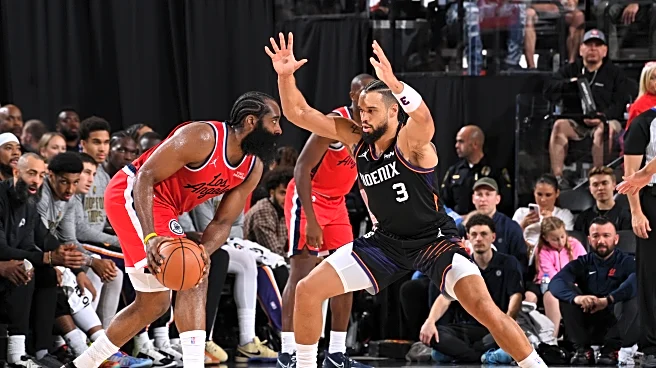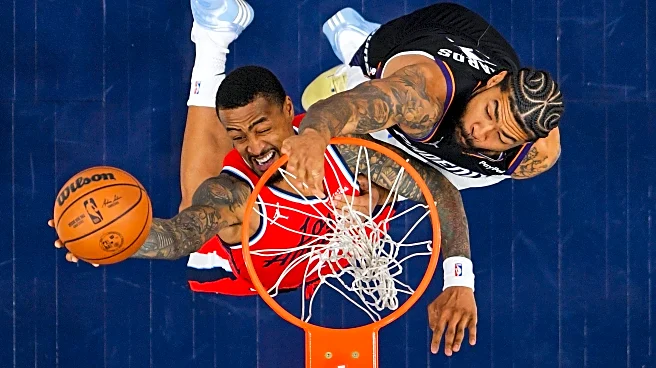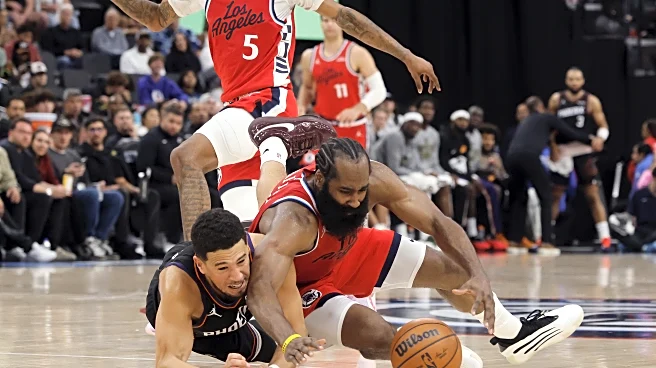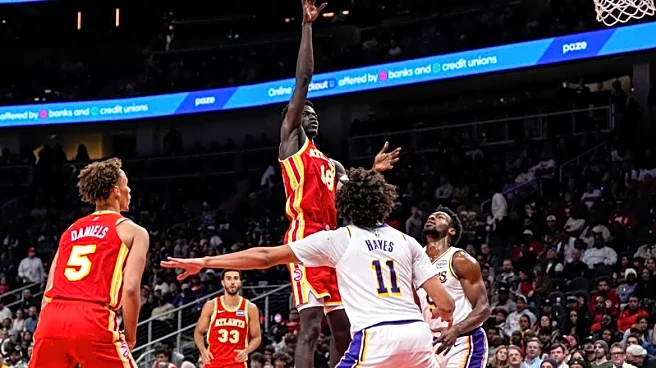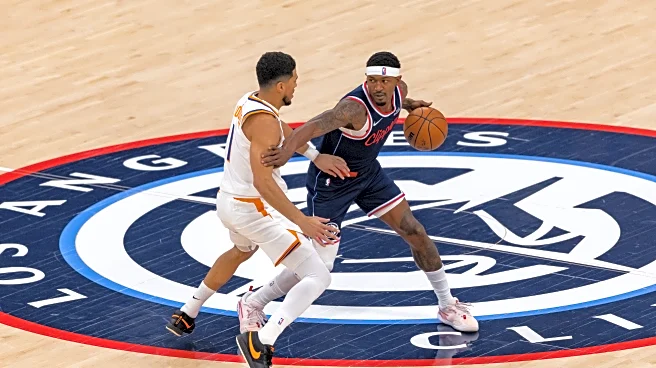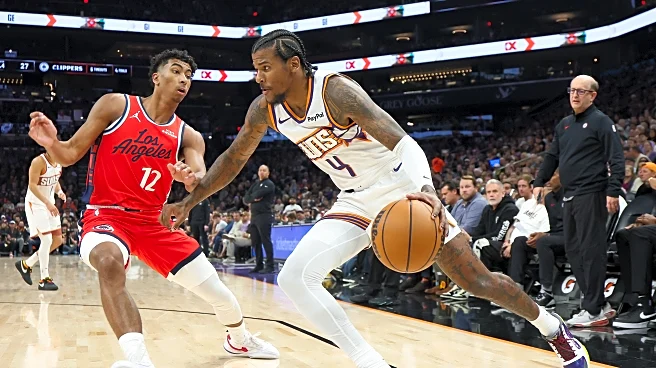It was the third matchup of the season against the Clippers and Saturday night. The first two games were split: a win without Harden or Leonard, and a loss where our defense collapsed. This time, Harden was present
and yet Phoenix came out on top. Let’s dive into how our defensive organization made the difference.
Context and Match Statistics
This was already our 10th game of the season, and nearly a third of them have been against the Clippers, whom we now lead 2-1 against. It was finally a chance to test ourselves at full strength (Brooks was present), but unfortunately, Jalen Green went down early with a hamstring injury.
The Suns as we know them didn’t exist in the first meeting. The second was much more positive, but without James Harden and Kawhi Leonard. And this third matchup aimed to confirm Phoenix’s progress and recent defensive trend against an elite creator like The Beard, who was present this time.
Statistically, nothing extraordinary: the Suns held them to 103 points (the third time in five games they’ve limited opponents to under 105 points), but they were overall very efficient: 59.7 eFG% and 12.4 TOV% (via CleaningTheGlass.com).
The Clippers were extremely efficient in the paint and on short-mid range shots (31-of-41), but completely struggled the farther they moved from the basket: 0-of-3 on long-mid, 2-of-9 on corner threes, 8-of-23 on other threes (via CleaningTheGlass.com).
These numbers set the stage for the Suns’ defensive read: a suffocating perimeter defense, but a vulnerability in the paint. Let’s see how the team executed this plan to limit such a talented opponent.
Defensive Philosophy and Game Plan
From the start, the goal was clear: apply high pressure to contain Harden (Dillon Brooks was tasked with staying on him), switch on every screen, help and double-team whenever a player was in the post or the paint to isolate him and force mistakes (double-teams always happening after the dribble).
A perfect example below: Brooks pressures Harden to force the pass to Zubac in the post, automatic switch between Dillon and Booker. Zubac makes the mistake of stopping his dribble and finds himself surrounded by three Suns players.
The first possessions show the team wanted to control the tempo, forcing the Clippers away from their comfort zones, especially the pick-and-roll, which wasn’t an easy task against specialists like Harden and Zubac.
On rotations, help is quick but measured: every player knows their role, closeouts are prioritized on shooters, and rim protection remains central. Though a paint shot still often results in points.
Even against aggressive Clippers sets, the defensive structure held: the game plan was applied, and the first quarter served as the foundation to adjust based on the strengths of the opponent and the Harden-Zubac relationship.
Defensive Breakdown
The perimeter is well-covered, but the interior suffers too much. The Suns lack size and power, and let’s be honest: the Clippers are very talented inside. Ivica Zubac and John Collins finished the game 16-of-18.
But the Suns didn’t back down. They know their strengths, and the whole team is confident; they forced the Clippers to operate outside their comfort zones, making them commit errors.
For instance, the paint is sealed off to prevent drives and to cut passing lanes to Zubac (as Allen is doing). Dunn has to swing the ball to Collins, who tries to go solo.
Another example of strong defensive organization: Royce O’Neale on Harden, forcing him to drive right to limit passing lanes. Harden initiates his drive, and Mark Williams comes over to contest.
Also here: Zubac in the high post is completely isolated from his teammates, trying to go past Mark but failing. The team stays in half-position: structured yet ready to help or close out as needed.
Finally, to finish the first half: high pick-and-roll between Harden and Zubac, Booker leaves Batum to help, Harden sees it, but Royce O’Neale is there to intercept. Errors are forced, shots pushed farther away.
In the second half, the picture evolves: the Clippers continue attacking the paint through their key players, but become more efficient on certain sequences. The Suns stick to the game plan, limiting drives and paint opportunities while dealing with more precise shots and slightly less perfect rotations in the third quarter.
Focus on the Harden Interior Connection
After suffering a lot in the first quarter, the main goal was to cut any link between Harden and his big men, even if it meant leaving open three-point spots or forcing long closeouts.
Harden is isolated and double-teamed in the corner by Williams and Booker (Dunn is temporarily left), while Goodwin and Brooks cover the bigs. Harden passes to Dunn; Brooks steps up, Goodwin goes to Zubac, and Allen helps to once again seal the paint. Jones Jr. and Collins are left open at three, but thanks to Grayson’s perfect closeout, no “easy and efficient” shot goes through.
Or here: pick-and-rolls between Harden and Zubac. Brooks and Williams defend directly, Dunn positions in Lowman, and Booker and Gillespie are ready to help on any pass or drive, leaving three-point spots open again.
Another example: Derrick Jones Jr. (not a big, but instructive). This sequence highlights areas the Suns need to work on: defending cuts and managing the intermediate spaces between defenders. The defense remains solid, but anticipatory improvements are needed.
One last clip: Dunn on Harden, forcing him to play right-handed. Richards helps, and just when you think the play is over, Harden finds Collins cutting behind Booker — the big man finishes with ease.
This section clearly shows that defensive success relies as much on collective effort as on individual reading, especially against a guard capable of creating opportunities for his bigs instantly.
Defensive Summary and Lessons
This matchup confirms that the Suns have a clear defensive identity: aggressiveness, communication, quick rotations, and constant help to push opponents out of their comfort zones.
The first half was about establishing the plan: protecting the paint, switching on screens, contesting drives, and limiting Harden’s connections with his bigs. For the rest of the game, the defense held up overall, though the Clippers became more efficient in the third quarter, exploiting small gaps or open perimeter shots.
The sequences analyzed show that success depends as much on collective cohesion as on individual anticipation: every player must understand their role, read passes and cuts, and be ready to help or close out. The efforts of Brooks, Dunn, Williams, O’Neale, and Allen perfectly illustrate this philosophy.
In conclusion, this game highlights that the Suns can contain elite creators while sticking to a flexible team plan, but mastering certain details — paint protection, intermediate spaces, and pick-and-roll management — remains key to turning good intentions into consistent success.
The next challenge will be to confirm this defensive discipline in upcoming games and prove that this trend can become a consistent standard.
